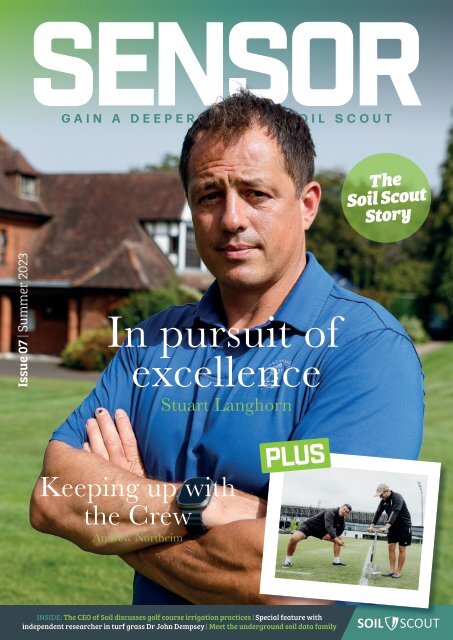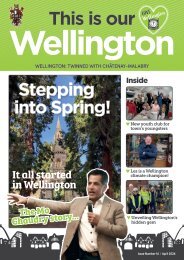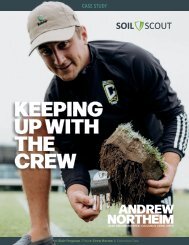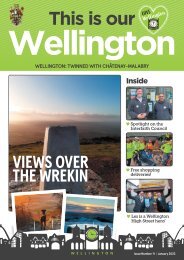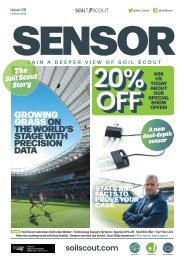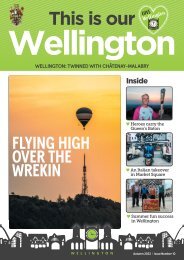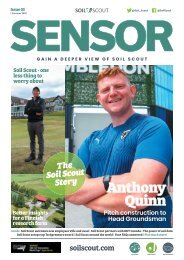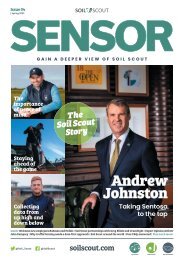You also want an ePaper? Increase the reach of your titles
YUMPU automatically turns print PDFs into web optimized ePapers that Google loves.
SENSOR<br />
GAIN A DEEPER VIEW OF SOIL SCOUT<br />
The<br />
<strong>Soil</strong> <strong>Scout</strong><br />
Story<br />
Issue 07 | Summer 2023<br />
In pursuit of<br />
excellence<br />
Stuart Langhorn<br />
Keeping up with<br />
the Crew<br />
Andrew Northeim<br />
PLUS<br />
INSIDE: The CEO of <strong>Soil</strong> discusses golf course irrigation practices | Special feature with<br />
independent researcher in turf grass Dr John Dempsey | Meet the underground soil data family
500 +<br />
WORLDWIDE CUSTOMERS<br />
TRUST SOIL SCOUT<br />
5,000 +<br />
HYDRA SCOUT SENSORS<br />
BURIED AROUND THE WORLD<br />
210,000<br />
NEW SOIL MEASUREMENTS<br />
EVERY DAY
200<br />
MILLION SOIL MEASUREMENTS<br />
SINCE 2013<br />
9,000<br />
NEW SOIL MEASUREMENTS<br />
EVERY HOUR<br />
50 GB<br />
SOIL MEASUREMENT DATA<br />
COLLECTED SINCE 2013
CEO OF SOIL<br />
Greener golf: The transition to<br />
responsible water management<br />
is a hole-in-one for golf's future<br />
<strong>Soil</strong> <strong>Scout</strong> CEO Jalmari Talola discusses why golf courses should now more than<br />
ever prioritise and further optimise their irrigation practices.<br />
Golf, often considered a leisurely pursuit, is<br />
more connected to the environment than<br />
one might think. Across the globe, lush golf<br />
courses, with their meticulously manicured<br />
greens and fairways, are a common sight.<br />
However, the environmental impact of these sprawling<br />
landscapes cannot be ignored. In this editorial, we delve into<br />
why golf courses should prioritise and further optimise their<br />
irrigation practices.<br />
Preserving precious resources<br />
Water is an invaluable resource, and its scarcity is a growing<br />
concern. Golf courses are notorious water consumers, often<br />
using vast amounts to maintain their pristine appearance.<br />
In a world where water shortages are increasingly common,<br />
it's imperative for golf courses to optimise their irrigation<br />
methods. By doing so, they can reduce their ecological<br />
footprint and contribute to water conservation efforts.<br />
Sustainability is par for the course<br />
The modern world demands sustainability in every<br />
aspect of life, including recreation. Golf courses are no<br />
exception. Embracing sustainable irrigation practices not<br />
only aligns with environmental ethics but also enhances<br />
a golf course's reputation. Eco-friendly golf courses are<br />
attractive to environmentally-conscious players, members,<br />
and communities, making them stand out in a competitive<br />
industry.<br />
Financial sense<br />
Optimising irrigation isn't just about environmental<br />
responsibility; it's also about fiscal prudence. Excessive water<br />
usage drives up maintenance costs, including water bills<br />
and energy expenses. By implementing advanced irrigation<br />
technologies such as soil moisture sensors, golf courses<br />
can precisely control water application, thereby reducing<br />
operational costs and increasing overall efficiency.<br />
Environmental stewardship<br />
Golf courses occupy substantial land areas, and<br />
the impact of their operations on local ecosystems<br />
can be significant. Excessive irrigation can lead to<br />
soil erosion, water pollution, and harm to nearby<br />
habitats. By adopting responsible irrigation<br />
practices, golf courses can mitigate these negative<br />
effects and even become hubs for biodiversity<br />
conservation. Vast number of courses have already<br />
adapted sustainable actions in their operations,<br />
and it is becoming the next big trend in the sport.<br />
Enhancing playability and aesthetics<br />
Optimising irrigation is not just about cutting<br />
back on water; it's also about improving the<br />
golfing experience. Properly irrigated courses<br />
offer consistent playing conditions, with firm<br />
and fast greens and fairways. This not only<br />
enhances the enjoyment of the game but also<br />
4 soilscout.com | @<strong>Soil</strong>_<strong>Scout</strong> | #GainADeeperView
CEO OF SOIL<br />
By implementing advanced irrigation technologies such as<br />
soil moisture sensors, golf courses can precisely control<br />
water application, thereby reducing operational costs<br />
and increasing overall efficiency<br />
Jalmari Talola<br />
reduces downtime for maintenance and<br />
course closures due to waterlogged<br />
conditions.<br />
Community and regulatory<br />
expectations<br />
Many communities and governments<br />
are enacting stricter regulations on<br />
water usage and environmental<br />
impact. Golf courses that<br />
pro actively optimise their<br />
irrigation systems demonstrate<br />
a commitment to compliance<br />
with these regulations<br />
and show respect for local<br />
ecosystems. This can lead to<br />
more favourable relationships<br />
with authorities and<br />
communities.<br />
The future of golf<br />
In a world facing environmental<br />
challenges, golf courses must adapt and<br />
evolve to remain relevant. Optimising irrigation isn't just<br />
a choice; it's a necessity for the industry's sustainability.<br />
By embracing efficient irrigation practices, golf courses<br />
can lead the way in demonstrating environmental<br />
responsibility while maintaining the beauty and quality<br />
of the game. The transition to responsible water<br />
management is a hole-in-one for the sport's future.<br />
In conclusion, optimising irrigation on golf courses<br />
is a win-win proposition. It conserves precious water<br />
resources, enhances sustainability, reduces operational<br />
costs, improves playability, and strengthens the<br />
industry's reputation. It's time for golf courses to tee up<br />
for a greener, more sustainable future.<br />
Contact Jalmari<br />
jalmari.talola@soilscout.com<br />
#GainADeeperView | @<strong>Soil</strong>_<strong>Scout</strong> | soilscout.com 5
INTERVIEW<br />
In pursuit of<br />
excellence<br />
There are many facets to<br />
the pursuit of excellence.<br />
Often it starts with the<br />
person themselves and<br />
then develops with the<br />
people who teach them. In the case of<br />
Beaconsfield Course Director Stuart<br />
Langhorn, it’s a healthy mix of both.<br />
Like many others in this industry, his love<br />
of sports led him to his current job. Playing<br />
football, rugby, cricket and running cross<br />
country at school is evidence of his passion<br />
for sport, but finishing his rugby career as<br />
a 40-year-old league winner cements it.<br />
His initial plan was to work as a Premier<br />
League groundsman, which led him to<br />
Myerscough College. Deciding to join his<br />
best friend, who was spending the summer<br />
at Wembley, Stuart went to the All England<br />
Tennis Club under Eddie Seaward in the<br />
pursuit of excellence.<br />
“We both wanted to work somewhere<br />
that was top of its game and to learn that<br />
excellence,” Stuart explained. “I spoke<br />
to a couple of guys who had been to<br />
Wimbledon the previous year, and they<br />
said Eddie Seaward was the guy to learn<br />
from.<br />
“I think it’s the attention to detail and<br />
the accuracy. It’s more than cutting grass,<br />
and there’s just no stone left unturned, and<br />
if you do turn a stone over somewhere like<br />
that, you turn it over a second time, a third<br />
time and a fourth time. You make sure<br />
you’ve tripled checked everything to make<br />
sure it’s right.<br />
“That’s something that I’ve always taken<br />
with me in every job, that bit of excellence.<br />
“From there, I planned to move into<br />
football, but I was still playing pretty<br />
competitive rugby, and that being on a<br />
Saturday meant I had to look for a different<br />
option. Someone suggested greenkeeping<br />
to me, and from there, I landed a job at<br />
Woburn on the new Marquis Course in<br />
1999.”<br />
Wimbledon gave Stuart meticulous<br />
attention to detail, but Woburn taught<br />
him greenkeeping. Arriving as a 20-yearold,<br />
Stuart had no experience, but<br />
his enthusiasm for learning and the<br />
environment he was working in took him<br />
forward and eventually to Burhill Golf Club<br />
and Leisure.<br />
“At Woburn, it was all about excellence<br />
and providing for the best players in<br />
Europe. We were a big venue for visitors<br />
paying a lot of money, and I’d really learnt<br />
<strong>Soil</strong> <strong>Scout</strong> has been the biggest<br />
thing that has revolutionised our<br />
approach to greenkeeping<br />
Stuart Langhorn<br />
Words Blair Ferguson | Pictures James Baylis<br />
6 soilscout.com | @<strong>Soil</strong>_<strong>Scout</strong> | #GainADeeperView
INTERVIEW<br />
STUART<br />
LANGHORN<br />
BEACONSFIELD GOLF CLUB, COURSE DIRECTOR<br />
#GainADeeperView | @<strong>Soil</strong>_<strong>Scout</strong> | soilscout.com 7
INTERVIEW<br />
The sensors are one thing that<br />
reassures my decision-making<br />
processes and gives me that ability<br />
to justify the spend<br />
Stuart Langhorn<br />
the greenkeeping side of the job. But, coming<br />
in at 20 years old, there are a lot of guys<br />
ahead of you for promotion at clubs like that.<br />
“So, after speaking to people within the<br />
industry, I went and joined Burhill Golf and<br />
Leisure as a Deputy Head Greenkeeper.<br />
Within a year, I quickly got promoted to<br />
Course Manager, and that was the learning<br />
curve I needed for the next six years.<br />
“Straight away, I was building and running<br />
budgets, ordering materials, stock sheets and<br />
running health and safety. The kind of things<br />
that I’m not sure everybody does in every<br />
golf club, but when you’re part of a group,<br />
they do take a bit of a punt on you, but they<br />
do ask you to do everything.<br />
“For me, it was amazing. It was a bit like<br />
an academy where you learnt everything.<br />
Aldwickbury Park was my course, and it was<br />
a private members club, but it was also a big<br />
visitor destination. And that’s where I learnt<br />
about having to be good 52 weeks a year.<br />
“At Woburn, we peaked for the<br />
tournaments. Whereas at a visitor venue<br />
that relies on repeat spending, if you give<br />
someone a bad experience, they won’t<br />
return. We really focused on that in the<br />
52 weeks; you can’t have an off day. I liked<br />
that because I liked the challenge, it was<br />
competitive, and they made it competitive<br />
throughout the group and from my sporting<br />
background, I really enjoyed it.”<br />
Coming to his peak at Burhill meant Stuart<br />
looked for a different challenge. Ultimately<br />
Beaconsfield was his opportunity to combine<br />
his ethos of providing European Tour quality<br />
with the repetitive attention to detail of a 52<br />
weeks a year visitor site.<br />
Benchmarking and self-auditing were<br />
his chosen methods, and the results speak<br />
for themselves ten years on. Initially, he<br />
encouraged his team to play golf and visit<br />
courses they aspired to be. Quickly, the<br />
quality of those courses increased until they<br />
were visiting clubs like The Berkshire, Woking,<br />
Swinley Forest and Sunningdale.<br />
Stuart explains: “Once a week, we make<br />
sure we walk out of the front door of the<br />
clubhouse and walk to the first tee how<br />
the golfer would, and not do the typical<br />
greenkeeper thing of coming through the<br />
woodland from the lefthand side.<br />
“That’s probably the biggest thing we do<br />
with our team, and that leads to the leaving<br />
no stone unturned. And the little things like<br />
making sure the tee blocks are pointing down<br />
the hole, making sure on a par three, if the<br />
pin is on the left of the green, the blocks are<br />
on the right of the tee, so there is a clear<br />
line of sight. That’s what I think it is. It’s that<br />
repetition, and it’s that constant auditing and<br />
benchmarking yourself.”<br />
As someone who appreciates detail, taking<br />
moisture readings is something Stuart did in<br />
the past, but with the common issues of the<br />
time it takes and the data arriving too late<br />
for morning hand watering.<br />
Another issue he had with manual<br />
methods is not knowing the trend. For<br />
Stuart, knowing whether the moisture<br />
level is trending up or down is crucial, and<br />
with the <strong>Soil</strong> <strong>Scout</strong>s, he can easily get this<br />
information.<br />
“We introduced PCD rope drainage into<br />
the greens six years ago, which has been<br />
great, and we’ve been moving forward<br />
with products, but since the rope <strong>Soil</strong><br />
<strong>Scout</strong> has been the biggest thing that<br />
has revolutionised our approach to<br />
greenkeeping,” Stuart said.<br />
“Say our target is 20%, the team can come<br />
in, and it’s 21%, but for me, I don’t know what<br />
8 soilscout.com | @<strong>Soil</strong>_<strong>Scout</strong> | #GainADeeperView
INTERVIEW<br />
#GainADeeperView | @<strong>Soil</strong>_<strong>Scout</strong> | soilscout.com 9
INTERVIEW<br />
that means with hand probing.<br />
“We always worked on training and<br />
educating the guys on hot spots, and once<br />
they start going, teaching all the guys which<br />
areas need watering. So that’s how we<br />
worked without buying technology.<br />
“The minute the <strong>Soil</strong> <strong>Scout</strong> came, that<br />
ticked every box for me because it was realtime.<br />
What I could do, and this isn’t being<br />
over-obsessive with my job, I could have a<br />
quick look before I went to bed and then<br />
again when I wake up in the morning sat with<br />
a cup of tea.<br />
“And going back to before when I said our<br />
target could be 20%, and the guys come<br />
back, and it’s 21%. Well, I need to know where<br />
it was before it was 21%. So now, I can look in<br />
the morning, and they are 21%, but the night<br />
before, they were 28%; they’ve come down,<br />
and with the heat of the day coming, I know<br />
they are on a downward trend.<br />
“So, even though the 21% is technically<br />
correct, we’re in trouble that day, and we<br />
need to get on it. And vice versa, we could<br />
look at the greens and see some dry spots,<br />
but we can actually see the numbers are<br />
coming up from 16%, and it’s on an upward<br />
trend from the night before.<br />
“That’s where it’s changed it for me and<br />
made it a real benefit. And also, that’s a<br />
one-man job. All the team have it on their<br />
phones, so they know, and we don’t have<br />
to waste four or five hours with someone<br />
walking around with a stick.<br />
“It really changed our approach to<br />
irrigation this year in the hottest and driest<br />
year we’ve had. We moved our sensors<br />
around the course to our 18th green and put<br />
them in at two, four, six, and eight inches.<br />
That way, we felt like we were absolutely<br />
nailed on where the moisture was at every<br />
part of the profile. I slept a bit easier doing<br />
that.<br />
“Our visitor golfers were astounded by<br />
the condition of our course other than the<br />
greens, and I think that was because we<br />
were able to reduce the amount of water on<br />
the greens and use it elsewhere around the<br />
course.<br />
“I don’t know if we were lucky or what,<br />
but we chose a good year to start with the<br />
<strong>Scout</strong>s in 2022. It just gives you that piece<br />
of mind, and it also gives you that little bit<br />
in the morning just to give you a little pat on<br />
10 soilscout.com | @<strong>Soil</strong>_<strong>Scout</strong> | #GainADeeperView
INTERVIEW<br />
the back with which way you’re going.<br />
“At the end of the day, your greens are<br />
everything. You can have the best fairways<br />
or tees, but the greens are the bread and<br />
butter of our industry, and if you’ve got good<br />
greens, you’re 99% of the way there.”<br />
Getting the best greens is more than<br />
irrigation, and using the sensors has helped<br />
Stuart refine the timing of applications.<br />
Everything is more expensive than it was four<br />
or five years ago, and the pressures of the<br />
job and golfer expectations have risen.<br />
This means getting the most from what<br />
he’s got and not applying products using predefined<br />
time frames.<br />
“It’s quite easy in my job to do something<br />
every two, three or four weeks. But actually,<br />
with <strong>Soil</strong> <strong>Scout</strong>, we know what the drying and<br />
wetting process looks like when our wetting<br />
agent is tailing off. So, we can put our next<br />
application on, which might be after 14<br />
days because it’s been that hot and there’s<br />
that much water going on; it’s washing the<br />
product through.<br />
“And vice versa, we might actually get a<br />
month out of the product. So it’s adding to<br />
our integrated pest management, although<br />
the drying out isn’t a pest, it is a pest for<br />
the turf because it is a problem. It’s allowing<br />
us to apply at the exact time the ground<br />
needs it rather than just sticking to the oldfashioned<br />
time frames.<br />
“The sensors are one thing that reassures<br />
my decision-making processes and gives me<br />
that ability to justify the spend. For example,<br />
we’re introducing a new bent seed from<br />
America that could be a bit more costly than<br />
the older variety. It is working, but one of<br />
the reasons it’s working is that our times of<br />
application are good because we’re using<br />
data to make the decisions.<br />
“I probably didn’t realise how much I’d<br />
use the data. There aren’t many things<br />
people worry about in summer as much as<br />
irrigation. It’s getting tougher every year.<br />
The pressure on the amount of water we’ve<br />
got, the windows we can do it, and the<br />
expectation of golfers are going up.<br />
“But our role is getting tougher with<br />
pressure from the climate and pressure from<br />
the economy and money that’s coming into<br />
the clubs. Anything that helps me is good,<br />
but this has been a real game changer.”<br />
Our role is getting tougher with pressure from the<br />
climate and pressure from the economy, anything<br />
that helps me is good, but <strong>Soil</strong> <strong>Scout</strong> has been a<br />
real game changer<br />
Stuart Langhorn<br />
#GainADeeperView | @<strong>Soil</strong>_<strong>Scout</strong> | soilscout.com 11
THE POWER OF<br />
DATA KNOWLEDGE.<br />
EXCLUSIVE DISTRIBUTOR IN THE UK<br />
BOOK A DEMO<br />
AT BERNHARD.CO.UK<br />
ON +44 (0) 1788 811 600<br />
OR EMAIL SALES@BERNHARD.CO.UK
WE ARE VERY PLEASED TO<br />
HAVE BERNHARD ON BOARD<br />
AS THE SOIL SCOUT UK<br />
DISTRIBUTOR AND BRING<br />
THE COMPANY’S 100+<br />
YEARS OF EXPERIENCE<br />
TO THE SOIL SCOUT FAMILY.<br />
JALMARI TALOLA<br />
SOIL SCOUT CEO<br />
Bernhard and Company leads the way in<br />
providing turf health solutions to the industry and<br />
our partners. Our best-in-class products, training<br />
and support partnerships deliver exceptional<br />
performance to sports venues worldwide.<br />
We deliver the best possible quality<br />
of turf with simplicity, ease and accuracy.
INTERVIEW<br />
Keeping up with<br />
the Crew<br />
The Columbus Crew hold<br />
their own story in the<br />
history of Major League<br />
Soccer. As MLS’ first<br />
franchise, its evolution has<br />
mirrored the league’s, and on and off the<br />
field, it's been a case of keeping up with the<br />
Crew.<br />
Opening in 1999, Historic Crew Stadium<br />
was the United States' first purpose-built<br />
professional soccer arena, signalling the<br />
league's development. Many teams have<br />
followed in building their own soccerspecific<br />
stadium, but the Crew haven’t stood<br />
still.<br />
The possibility of relocation loomed<br />
over the franchise, but in 2019, Dee and<br />
Jimmy Haslam, Whitney and JW Johnson<br />
and long-time team physician Dr. Pete<br />
Edwards received operating rights of the<br />
club and made their intentions known with<br />
investment.<br />
In 2021, the 20,371 capacity Lower.com<br />
Field and the renovation of OhioHealth<br />
Performance Center (OHPC), connected to<br />
Historic Crew Stadium, ushered in a new era<br />
for the two-time MLS Cup winners.<br />
For nine years, Head Groundskeeper at<br />
OHPC, Andrew Northeim, has been part of<br />
the Crew’s journey and seen the transition<br />
to best-in-class facilities. When he joined in<br />
2014 after graduating from The Ohio State<br />
University with a Bachelor’s of Science,<br />
Andrew worked at both facilities and<br />
gained valuable knowledge before taking<br />
his current role in 2018.<br />
The development of OHPC was an<br />
opportunity to gain field construction<br />
experience and, with the positive backing<br />
of the new owners, embrace the best field<br />
technology the industry had to offer.<br />
"When we were initially brought in on the<br />
build and heard that SubAir and hydronic<br />
heating was included, it was a pretty big<br />
thing," Andrew explains. "Knowing that<br />
our ownership was willing to invest in the<br />
<strong>Soil</strong> <strong>Scout</strong> is awesome technology<br />
to have once you have it and<br />
know how reliable it is<br />
Andrew Northeim<br />
Words Blair Ferguson | Pictures Drew Horton © Columbus Crew<br />
14 soilscout.com | @<strong>Soil</strong>_<strong>Scout</strong> | #GainADeeperView
INTERVIEW<br />
ANDREW<br />
NORTHEIM<br />
HEAD GROUNDSKEEPER, COLUMBUS CREW, OHPC<br />
#GainADeeperView | @<strong>Soil</strong>_<strong>Scout</strong> | soilscout.com 15
INTERVIEW<br />
facilities and fields was a big step.<br />
"At our old training facility, we barely<br />
had drainage. It was clay soil with maybe a<br />
couple of inches of sand on top, and anytime<br />
it rained, we had puddles across the fields,<br />
which we called bird baths.<br />
"So, getting 10 inches of sand for our soil<br />
system was great, but having the SubAir and<br />
hydronic heating on top of that was the icing<br />
on the cake."<br />
Having these technologies in two of the<br />
three and a half fields is one thing, but<br />
controlling and monitoring them is another.<br />
After being introduced to <strong>Soil</strong> <strong>Scout</strong> and all<br />
it would do for the groundskeeping team,<br />
Andrew quickly utilised them across the site.<br />
"Over the years being in groundskeeping,<br />
my biggest positive is that I'm not afraid to<br />
try anything new technology or equipment<br />
based. I love the latest technology, trying it<br />
out, seeing what I like, and seeing if there is<br />
anything bigger and better out there.<br />
"Seeing what <strong>Soil</strong> <strong>Scout</strong> could do with<br />
SubAir and our hydronic heating was eyeopening<br />
– how they control and automate<br />
those systems together seamlessly, while<br />
watching the data, moisture and soil<br />
temperatures from wherever you are is a<br />
game changer.<br />
16 soilscout.com | @<strong>Soil</strong>_<strong>Scout</strong> | #GainADeeperView
INTERVIEW<br />
"Once I looked into it, I saw <strong>Soil</strong> <strong>Scout</strong><br />
isn't a new technology, it's a technology that<br />
keeps improving, and more and more people<br />
are realising it's a benefit to groundskeepers<br />
across the globe like it has been in<br />
agriculture.<br />
"We have SubAir in two of our training<br />
fields, but we have three and a half grass<br />
fields. After about six months, I quickly<br />
realised that I needed to get more <strong>Soil</strong> <strong>Scout</strong>s<br />
in the other fields. We were given 36 sensors<br />
from the original build, and we’re currently on<br />
our way to 60+.<br />
"The sensors are just as valuable on the<br />
fields without SubAir, because we can see<br />
which fields don't dry out as quickly. They<br />
need their inputs at different times, and with<br />
<strong>Soil</strong> <strong>Scout</strong> in them, we can measure that and<br />
prevent waste."<br />
Subtle differences have become easier<br />
to spot for Andrew. Noticing when pitches<br />
are beginning to dry out is one, but watering<br />
that area separately without concern for the<br />
rest of the field and saving water is the real<br />
benefit.<br />
By using the <strong>Soil</strong> <strong>Scout</strong> cloud, he has<br />
streamlined his view of the pitches. A glance<br />
can reveal any variabilities in soil moisture<br />
or temperature, whilst looking a little deeper<br />
reveals short and long-term trends.<br />
The placement of the sensors drives this<br />
information. Andrew is already working at<br />
multiple depths of three and six inches, but<br />
a successful trial of the new <strong>Soil</strong> <strong>Scout</strong> dual<br />
sensor has shown him how that process will<br />
be enhanced further.<br />
Watching the data, moisture and<br />
soil temperatures from wherever<br />
you are is a game changer<br />
Andrew Northeim<br />
#GainADeeperView | @<strong>Soil</strong>_<strong>Scout</strong> | soilscout.com 17
INTERVIEW<br />
"Multiple depths are significant for us<br />
because that is what runs the hydronic<br />
heating," he explains. "It goes off of the<br />
three-inch average soil temperature. If that<br />
drops below a half degree, then the heating<br />
kicks in.<br />
"You have to rely on those to run the<br />
system, and we have no issues with that.<br />
It's an awesome technology to have once<br />
you have it and know how reliable it is."<br />
Time doesn't stand still in MLS for long.<br />
Superstars such as David Beckham come<br />
as players and return as club owners, and<br />
the league's stature grows to attract this<br />
generation's greatest player, Lionel Messi.<br />
Matching the pace of change is<br />
imperative so you're not left behind, but in<br />
the Crew, MLS has a team setting the pace<br />
from a grounds perspective, which Andrew<br />
thinks benefits the league.<br />
"Being in this league for nine years, it<br />
has grown immensely. Just being on the<br />
groundskeeping side, you see all of the new<br />
facilities and teams coming in, building new<br />
stadiums and training fields, and putting in<br />
the right technologies for those fields.<br />
"I think that goes a long way from the<br />
groundskeeping side in improving the<br />
league for the long term. It's been crazy<br />
from where we've come from at our old<br />
training fields and even our old stadium.<br />
"Our old stadium was great, other teams<br />
loved coming here, but it was just a sandbased<br />
system that hadn't been replaced<br />
since 2006. So it was a 14-year-old field<br />
we did what we could with, and going from<br />
that to having all this, it shows there's a lot<br />
of new technology in the groundskeeping<br />
world that will help us become even better.<br />
"Ours was the first stadium built, and we<br />
were the first team in the league. Now we<br />
have our second stadium and OHPC, so I'd<br />
say Columbus Crew knows you have to keep<br />
growing with the league."<br />
18 soilscout.com | @<strong>Soil</strong>_<strong>Scout</strong> | #GainADeeperView
INTERVIEW<br />
<strong>Soil</strong> <strong>Scout</strong> is technology that keeps improving<br />
and more and more people are realising its a<br />
benefit to groundskeepers across the globe<br />
Andrew Northeim<br />
#GainADeeperView | @<strong>Soil</strong>_<strong>Scout</strong> | soilscout.com 19
OPINION<br />
<strong>Soil</strong> <strong>Scout</strong> - It's a long way<br />
from testing the ground<br />
with a screwdriver!<br />
By Dr John Dempsey<br />
Independent researcher in turf grass disease<br />
and physiology<br />
J_J_Dempsey<br />
So, over the past few years<br />
decades, I’ve transitioned from<br />
a young trainee greenkeeper,<br />
who’s first jobs included collecting<br />
the organic matter output<br />
from the rear ends of sheep to golf course<br />
superintendent and somehow ended up as<br />
turf grass pathologist. For most of that time,<br />
which stretches back to the 1980’s, the idea<br />
that you could sit back in your office or in<br />
your comfortable armchair at home or even<br />
by the poolside in a far-off holiday resort and<br />
be able to check on your pride and joy of a<br />
golf course to see what the moisture levels,<br />
soil temperatures and salt levels were, would<br />
have seemed like something from Star Trek!<br />
Superintendent’s hat<br />
Speaking with my superintendent’s hat<br />
on, the <strong>Soil</strong> <strong>Scout</strong> system has numerous<br />
benefits and if I’d had them back then, would<br />
have saved me an awful lot of worry. I’m<br />
sure most turf grass managers will identify<br />
with me when I say a long hot summer is not<br />
something we can enjoy. One of the problems<br />
we face is drought stress, our surfaces drying<br />
out and, usually by the time we visually<br />
identified problems, such as dry spots and<br />
wilt, the damage had been done! We were<br />
than faced with an uphill battle, not only<br />
to alleviate the problem, but also having to<br />
try and encourage recovery. Being able to<br />
constantly monitor Volumetric Water Content<br />
(VWC) allows us to take early preventative<br />
action, i.e. targeted surfactants, or hand<br />
watering…. prevention is always the better<br />
option!<br />
At the other extreme, as I noted during this<br />
winter’s cold spell, we can also record low<br />
soil temperatures, and if your sensor depths<br />
are staggered, temperatures at a range of<br />
centimetres below your surfaces. This is a<br />
handy option if you need to assess the effect<br />
of extended periods of cold weather. Also<br />
you’ll have irrefutable data if you want to<br />
enlighten golfers or committee members to<br />
the dangers of frost play and effects, such<br />
as root shear, and show them that while the<br />
surfaces may look frost clear, the soil below is<br />
still gripped by winter!<br />
Numerous studies<br />
Speaking now with my turf grass<br />
pathologist’s hat on (it’s like the<br />
superintendent’s hat but fancier) being able<br />
to continuously and remotely assess, and<br />
gather data on soil moisture, temperatures<br />
and salinity levels is an invaluable tool. Over<br />
the past number of years, I have carried<br />
out numerous studies, in areas of disease<br />
control, turf grass physiology and surfactant<br />
efficacy. One thing that can be noted, and<br />
when you think about it its self-evident, is<br />
that stressed turf grass is always significantly<br />
more susceptible to disease, pest damage and<br />
injury from extreme environment factors.<br />
Prevention and pre-emptive practices are<br />
always better than playing catch up with<br />
abiotically or biotically damaged turf grass.<br />
Here’s some examples of a biotic stress<br />
and how, by utilising <strong>Soil</strong> <strong>Scout</strong> sensors,<br />
it’s possible to detect them earlier than<br />
traditional means and head them off at the<br />
pass (my cowboy hat on now).<br />
l Areas prone to excess water/flooding:<br />
traditionally observed by brown turf grass<br />
following the outline of flooded areas; scalded<br />
appearance. <strong>Sensor</strong>s can help identify any<br />
areas inclined to retaining higher than<br />
average VWC and allow for remedial action.<br />
l Drought: foot printing, leaf rolling,<br />
browning of turf grass; tissue becomes brittle.<br />
<strong>Sensor</strong>s will show the VWC dropping towards<br />
dangerous levels and allow for pre-emptive<br />
action.<br />
l High temperatures: turf grass with<br />
water-soaked and brown appearance. <strong>Sensor</strong>s<br />
again will confirm excessive levels and allow,<br />
for example, syringing of canopy to cool.<br />
l Low temperature, frost injury:<br />
Straw-brown colour, bleached turf grass<br />
appearance, crown hydration, root shear.<br />
<strong>Sensor</strong>s again can be used to confirm depth<br />
and levels of soil freezing.<br />
Greenkeeping 101<br />
Regarding biotic stress, one of the major<br />
pathogens we face in Ireland and the UK is<br />
Anthracnose, and this is very much a stress<br />
related disease, so any means of reducing<br />
stress will contribute to less disease - pretty<br />
much Greenkeeping 101. Providing optimum<br />
moisture and adequate nutrition are key<br />
factors in preventing it, so being able to<br />
monitor the VWC, and salt levels are very<br />
20 soilscout.com | @<strong>Soil</strong>_<strong>Scout</strong> | #GainADeeperView
OPINION<br />
<strong>Soil</strong> <strong>Scout</strong> <strong>Sensor</strong> is the official<br />
magazine for <strong>Soil</strong> <strong>Scout</strong> Oy.<br />
Figure 1: Surfactant trial - Control plot vs Surfactant treated treated plot.<br />
Figure 1 Surfactant trial - Control plot vs Surfactant treated treated plot.<br />
<strong>Soil</strong> <strong>Scout</strong> Oy<br />
Lapinlahdenkatu 16<br />
00180 Helsinki<br />
Finland<br />
The views expresssed in <strong>Soil</strong> <strong>Scout</strong> <strong>Sensor</strong><br />
are those of the individual contributors<br />
and not necessarily the views of <strong>Soil</strong> <strong>Scout</strong><br />
Oy or Plus Two Media Limited who take no<br />
responsibility for them.<br />
All content is copyright © <strong>Soil</strong> <strong>Scout</strong> Oy 2023<br />
and may not be reproduced without written<br />
permission.<br />
Design & Layout<br />
JAMES BAYLIS<br />
Head of Creative Content<br />
james.baylis@soilscout.com<br />
Contributors:<br />
BLAIR FERGUSON, DR JOHN DEMPSEY<br />
& the <strong>Soil</strong> <strong>Scout</strong> team.<br />
Figure 2 Control plot vs Surfactant treated plot, soil moisture (VWC) measured May to<br />
Figure 2: Control plot vs Surfactant treated plot, soil moisture (VWC) measured May to September 2022.<br />
September 2022.<br />
helpful in preventing this problem.<br />
Likewise, with Microdochium infection, turf<br />
grass struggling with deficient moisture and<br />
nutrient levels are more prone to infection.<br />
Keeping on top of what’s going on in your root<br />
zones is crucial in the battle for healthy turf!<br />
I have used the <strong>Soil</strong> <strong>Scout</strong> sensors in my<br />
researcher role for the past 18 months and<br />
they have provided me with some excellent,<br />
up to the minute data during my trials. They<br />
were especially useful during surfactant<br />
research I carried out, giving me regular<br />
updates, allowing me to easily assess what<br />
effect and interaction the various treatments,<br />
irrigation and nutrient inputs had on trial<br />
plot root zones. And of course, moisture<br />
management in sports turf is much more than<br />
providing water to the plant. Ensuring correct<br />
infiltration and consistent water distribution<br />
also has significant effects on soil microbial<br />
populations, nutrient uptake, turf grass health<br />
and playing quality.<br />
I’ve also used them in some greenhouse<br />
work I did, assessing root zone physical<br />
amendments, sensors placed in growth<br />
vessels provided me with interesting and<br />
novel data.<br />
As superintendent, I would have loved<br />
to have had the <strong>Soil</strong> <strong>Scout</strong> system installed<br />
during my time, it would have saved me a lot<br />
of stressing, but also it would have allowed<br />
me to produced better and healthier playing<br />
surfaces, by allowing me to specifically<br />
target resources to areas prior to problems<br />
becoming problems!<br />
As a researcher I find the ability to access<br />
data instantly from any location very exciting<br />
(turf nerd here) and extremely useful.<br />
Overall, I can see the integration of <strong>Soil</strong><br />
<strong>Scout</strong> sensor technology with drone usage<br />
and irrigation controls to becoming standard<br />
operational procedure.<br />
A long way from testing the ground with a<br />
screwdriver!<br />
<strong>Soil</strong> <strong>Scout</strong> <strong>Sensor</strong> has been designed and<br />
printed by Plus Two Media Limited.<br />
For more information about design and<br />
publishing call: 07977 481186 or email:<br />
james@plus2media.co.uk<br />
#GainADeeperView | @<strong>Soil</strong>_<strong>Scout</strong> | soilscout.com 21
TECHNICAL<br />
Unlock the power of your data<br />
with the Analysis page<br />
By Johannes Tiusanen<br />
Chief Science Officer, <strong>Soil</strong> <strong>Scout</strong><br />
One of the most useful tools<br />
on the <strong>Soil</strong> <strong>Scout</strong> Hub is the<br />
Analysis page. While the<br />
regular Device view graphs<br />
overlay data from selected<br />
devices in the same time axis, which is a<br />
great way to get an overall view of your soil<br />
conditions and trends, sometimes you need<br />
to compare data from different times. That's<br />
where the Analysis page comes in handy.<br />
The Analysis page is a powerful tool that<br />
allows you to compare any data graphs from<br />
different times. For example, you can plot<br />
soil moisture from several growing seasons<br />
on top of each other to analyse the seasonal<br />
differences. You can also plot any parameters,<br />
such as temperature and salinity, into the<br />
same graph. The best part? You can save the<br />
created Analysis and it will be visible for other<br />
users of the same Site.<br />
Let's take a look at an example. Imagine you<br />
want to compare growing seasons 2020 and<br />
2022 from the Group "25 cm <strong>Scout</strong>s". With the<br />
Analysis page, you can easily plot the moisture<br />
graphs for both seasons and sync them based<br />
on growth stage rather than calendar. This<br />
way, you can see the differences between the<br />
two seasons and make informed decisions for<br />
the future.<br />
It's important to note that while you can<br />
add as many graphs as you wish, having too<br />
many can make the graph unclear. But don't<br />
worry, you can hide and show graph lines by<br />
clicking their legends.<br />
Another great feature of the Analysis page<br />
is that the graph lines are live. This means<br />
that an unfinished line will extend as data<br />
accumulates, and every time you open a<br />
particular Analysis the "ongoing season" graph<br />
will have grown longer.<br />
Creating an Analysis is easy. Simply click the<br />
"Create Analysis" button and give the analysis<br />
a familiar name which will also be understood<br />
by your colleagues. Then, add data to the<br />
graph by clicking the "Add Data" button and<br />
choosing the <strong>Scout</strong>s and/or Groups you wish<br />
to add. You can choose the same data multiple<br />
times if you wish to have several graphs from<br />
the same source but different times. Once the<br />
graphs appear in the plot, you can change the<br />
Data Type (moisture, temperature...) and the<br />
Start Date of each line.<br />
Your feedback is invaluable to us as we<br />
continue to improve our platform to better<br />
serve your needs. With the Analysis page, the<br />
possibilities are endless, and we can't wait to<br />
hear how it transforms the way you work with<br />
your data. Go ahead, create your own analysis,<br />
discover the power of your data and let us<br />
know how you feel about it!<br />
26 22 soilscout.com | @<strong>Soil</strong>_<strong>Scout</strong> | #GainADeeperView
Meet the <strong>Soil</strong> <strong>Scout</strong> family<br />
THE UNDERGROUND SOIL DATA EXPERT TEAM<br />
Jalmari Talola<br />
CEO<br />
jalmari.talola@soilscout.com<br />
Mobile: +358 40 820 1709 (Finland)<br />
Johannes Tiusanen<br />
Chief Science Officer<br />
johannes.tiusanen@soilscout.com<br />
Mobile: +358 44 3659799 (Finland)<br />
Jussi Sirkiä<br />
Chief Technology Officer<br />
jussi.sirkia@soilscout.com<br />
Mobile: +358 40 7242532 (Finland)<br />
Bahman Doaeian<br />
Sales Director EMEA<br />
bahman.doaeian@soilscout.com<br />
Mobile: +358 45 3499400 (Finland)<br />
Nick Durkin<br />
Sales & Sports Turf Specialist<br />
nick.durkin@soilscout.com<br />
Mobile: +44 7538 301753 (UK)<br />
Tommi Tienhaara<br />
Sales Chef<br />
tommi.tienhaara@soilscout.com<br />
Mobile: +358 40 5001792 (Finland)<br />
Christian Walter<br />
Sales Executive<br />
christian.walter@soilscout.com<br />
Mobile: +1 (813) 440 0499 (United States)<br />
Ville Oksanen<br />
Business Controller<br />
ville.oksanen@soilscout.com<br />
Mobile: +358 40 541 2213 (Finland)<br />
Miiro Jääskeläinen<br />
Underground Weatherman / Agronomist<br />
miiro.jaaskelainen@soilscout.com<br />
Mobile: +358 40 7449263 (Finland)<br />
Heikki Huhtanen<br />
Software Developer<br />
heikki.huhtanen@soilscout.com<br />
Mobile: +358 40 8418725 (Finland)<br />
sales@soilscout.com | www.soilscout.com<br />
#GainADeeperView | @<strong>Soil</strong>_<strong>Scout</strong> | soilscout.com 23
REAL-TIME GAINS<br />
BEGIN UNDERGROUND<br />
I'd definitely say the <strong>Soil</strong> <strong>Scout</strong><br />
sensors have given me peace of<br />
mind regarding decision making.<br />
Now, I go away at the weekend,<br />
and if I'm not sure it needs<br />
irrigation, I don't set anything<br />
because I've got the Rain Bird<br />
app.<br />
So, I'll sit at home watching TV,<br />
and at half nine, I'll look at <strong>Soil</strong><br />
<strong>Scout</strong>, put some water on if we<br />
need it, and go to bed happy.<br />
Ben Burrill, Course Manager<br />
The Hallamshire<br />
sales@soilscout.com | www.soilscout.com


